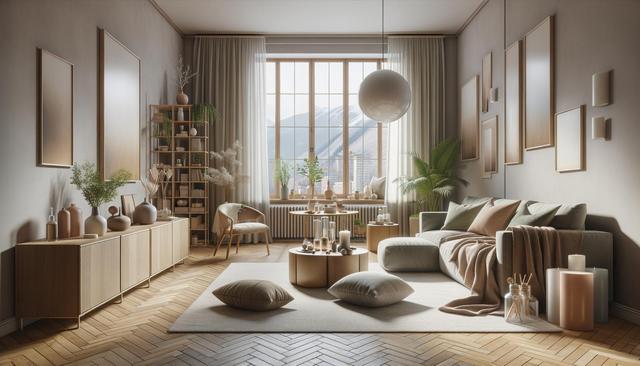
Home Decor Ideas 2025: Style Meets Simplicity
Embracing Nature Indoors
In 2025, the connection between indoor and outdoor living continues to strengthen. More homeowners are looking to introduce elements of nature into their homes, creating calm and revitalizing spaces. Natural materials such as wood, stone, and clay are being used not only for floors and countertops but also as decorative elements. From bamboo furniture to terracotta accent walls, these organic textures bring warmth and authenticity to interiors.
Plants are also playing a larger role in home decor. Beyond the aesthetic value, indoor greenery contributes to improved air quality and overall well-being. Consider these ideas:
- Install vertical gardens in kitchens or living areas
- Use oversized potted plants as focal points
- Incorporate hanging plants in window frames or corners
Natural light is another key element. Large windows, skylights, and glass doors are being integrated into design plans to allow sunlight to flood the interiors and enhance the earthy ambiance. In 2025, bringing the outdoors in is not just a trend—it’s a lifestyle choice that emphasizes sustainability and serenity.
Color Palettes and Textures to Watch
The color schemes for 2025 reflect a balance between soothing tones and bold statements. Neutral palettes, including soft grays, warm taupes, and creamy whites, remain popular for their versatility and calming effect. However, there is a noticeable shift toward incorporating rich, saturated hues as well. Deep blues, forest greens, and rust oranges are making their way into accent walls, furniture, and accessories.
Texture will also play a pivotal role in home decor. Designers are layering textiles and materials to add depth and visual interest. Expect to see combinations like:
- Velvet cushions paired with linen sofas
- Wool throws on rattan chairs
- Marble countertops with matte black hardware
These combinations not only create a sensory experience but also make spaces feel more curated and personalized. Wallpaper is making a comeback too, with modern prints and tactile finishes offering an alternative to traditional painted walls.
Smart and Functional Spaces
Technology continues to influence home design, with smart features becoming more seamlessly integrated into decor. In 2025, function and form go hand in hand. Home automation systems are being disguised within stylish fixtures and fittings, making them less obtrusive and more user-friendly. Think smart mirrors in bathrooms, voice-controlled lighting, and automated window treatments that respond to the time of day or weather conditions.
Multifunctional furniture is also gaining traction. With more people working from home or living in smaller spaces, every inch counts. Consider investing in:
- Sofas with built-in storage
- Convertible desks that double as dining tables
- Modular shelving units that adapt to changing needs
These elements not only maximize space but also contribute to a clutter-free, organized environment. As utility becomes more important, the challenge lies in maintaining aesthetic appeal without compromising on convenience.
Minimalism with Personality
Minimalist design remains a strong influence in 2025, but it’s evolving to include more personal touches. The emphasis is on quality over quantity—choosing fewer items that reflect one’s style and values. Clean lines, open spaces, and a neutral foundation provide the backdrop, while curated decor adds character and meaning.
To strike the right balance, consider these strategies:
- Display meaningful art or handcrafted items
- Use statement lighting fixtures to define spaces
- Mix modern pieces with vintage finds for contrast
Personalized minimalism also extends to color choices and materials. A minimalist room can still feature a bold rug or a vibrant piece of furniture, as long as the overall composition feels intentional and uncluttered. This approach allows homeowners to maintain a serene environment while expressing their unique taste.
Global Influences and Cultural Touches
Global design influences are shaping home decor in 2025, as people seek inspiration from different cultures and traditions. This trend celebrates diversity and craftsmanship, bringing a rich variety of textures, patterns, and stories into the home. From Moroccan tiles to Japanese-inspired simplicity, blending international elements creates spaces that feel both worldly and personal.
Travel-inspired decor can be achieved through:
- Ethnic textiles like kilim rugs or batik prints
- Handcrafted ceramics and pottery
- Wall art and souvenirs from meaningful trips
This global approach encourages sustainability by valuing artisanal goods over mass-produced items. It also adds depth to interiors, making them feel curated rather than designed. The key is to use cultural elements respectfully and thoughtfully, ensuring they complement the overall aesthetic rather than overwhelm it.
Conclusion: Designing with Intention in 2025
Home decor in 2025 is all about intentional design—creating spaces that are not only beautiful but also functional, sustainable, and reflective of personal values. Whether you’re drawn to natural materials, rich textures, or smart solutions, the trends moving forward encourage a thoughtful approach to styling your space. By blending global influences, embracing minimalism, and incorporating advanced functionality, your home can become a true sanctuary tailored to the way you live now and in the future.


